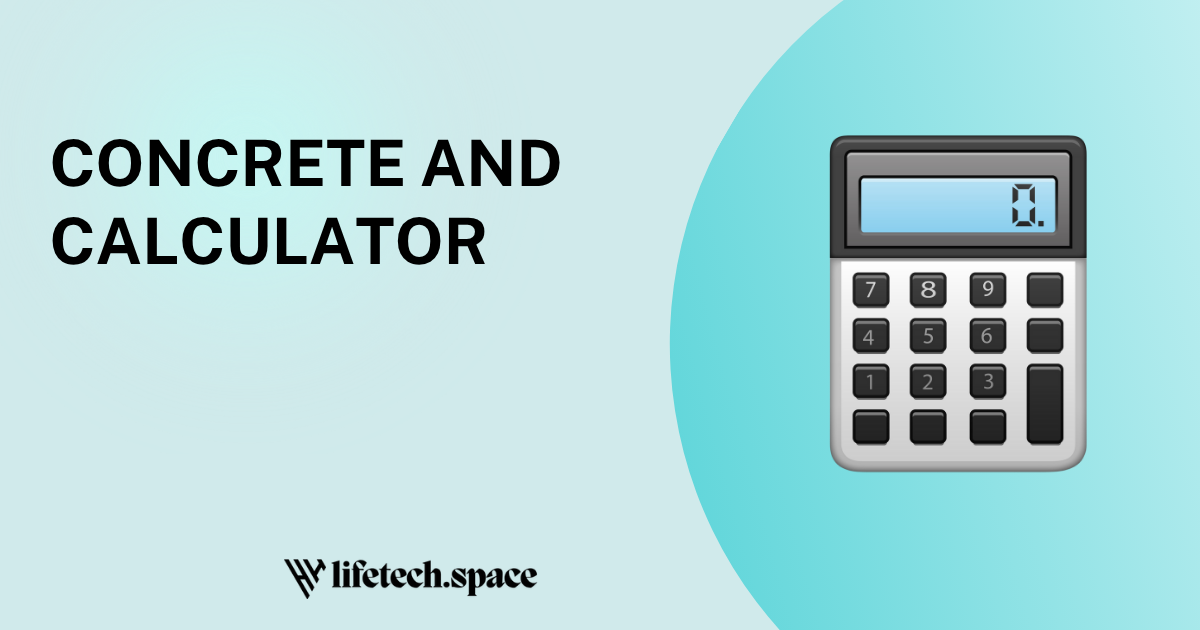Introduction
When planning a construction project, whether it’s a driveway, patio, or foundation, knowing how much concrete you need is critical. A concrete and calculator tool simplifies this process by providing quick, accurate estimates for your material needs. Whether you’re a DIY enthusiast or a professional contractor, a free concrete and calculator tool saves time, reduces waste, and ensures your project stays on budget. In this guide, we’ll explore how an online concrete and calculator works, its formula, and why it’s a must-have for any construction project. Let’s dive into this comprehensive concrete and calculator guide to make your next project a breeze!
What Is a Concrete and Calculator?
A concrete and calculator is an online tool designed to help users estimate the amount of concrete required for a construction project. By inputting dimensions like length, width, and depth, the calculator determines the volume of concrete needed in cubic yards or meters. This eliminates guesswork, prevents over-ordering, and ensures you purchase just the right amount of materials.
For example, imagine you’re pouring a concrete slab for a garage. Without a calculator, you’d need to manually compute the volume and account for variables like waste or uneven surfaces. A free concrete and calculator tool does this instantly, factoring in standard industry measurements. It’s perfect for projects like driveways, sidewalks, patios, or even small footings for a deck.
This tool is user-friendly, requiring no advanced math skills. Whether you’re a homeowner tackling a DIY project or a contractor managing multiple jobs, the concrete and calculator online provides reliable results in seconds.
How to Use the Concrete and Calculator
Using an online concrete and calculator is straightforward, even for beginners. Most calculators are accessible on both mobile devices and desktops, making them convenient for on-site or at-home planning. Here’s a step-by-step concrete and calculator guide to get started:
- Step 1: Gather Measurements
Measure the length, width, and depth (or thickness) of the area where you’ll pour concrete. Use feet or meters, depending on the calculator’s unit options. - Step 2: Access the Calculator
Visit a website offering a free concrete and calculator tool. Popular platforms include construction websites, home improvement stores, or dedicated calculator sites. - Step 3: Input Dimensions
Enter the measurements into the calculator’s fields. Some tools also allow you to adjust for waste (typically 5–10%) or select specific concrete types. - Step 4: Calculate and Review
Hit the “Calculate” button to get the total concrete volume in cubic yards or meters. The tool may also estimate bags of pre-mixed concrete for smaller projects. - Step 5: Save or Share
Many online calculators let you save results or generate a PDF for reference during purchasing.
Quick Reference Table: Common Concrete Projects
| Project Type | Typical Thickness | Calculator Input Example |
|---|---|---|
| Driveway | 4–6 inches | 20 ft x 10 ft x 0.5 ft |
| Patio | 4 inches | 12 ft x 12 ft x 0.33 ft |
| Sidewalk | 4 inches | 50 ft x 3 ft x 0.33 ft |
Whether you’re on your phone at the job site or planning from your desktop, the concrete and calculator online ensures fast, accurate results every time.
Concrete and Calculator Formula Explained
The concrete and calculator formula is based on a simple volume calculation:
Volume = Length × Width × Depth
This formula calculates the cubic footage (or meters) of the area to be filled with concrete. To convert cubic feet to cubic yards (the standard unit for ordering concrete), divide the result by 27, as there are 27 cubic feet in a cubic yard.
Here’s a breakdown of the formula components:
- Length: The horizontal distance of the project area (e.g., 20 feet for a driveway).
- Width: The width of the area (e.g., 10 feet).
- Depth: The thickness of the concrete slab, typically 4–6 inches (converted to feet, e.g., 4 inches = 0.33 feet).
- Waste Factor: Add 5–10% to account for spillage, uneven surfaces, or over-excavation.
Example Calculation
Let’s say you’re pouring a patio measuring 12 feet long, 12 feet wide, and 4 inches thick.
- Convert thickness to feet: 4 inches ÷ 12 = 0.33 feet.
- Calculate volume: 12 ft × 12 ft × 0.33 ft = 47.52 cubic feet.
- Convert to cubic yards: 47.52 ÷ 27 = 1.76 cubic yards.
- Add 10% for waste: 1.76 × 1.1 = 1.94 cubic yards.
You’ll need approximately 2 cubic yards of concrete for this patio. A free concrete and calculator tool performs these calculations instantly, saving you time and effort.
Why Use an Online Concrete and Calculator?
An online concrete and calculator offers numerous benefits for both DIYers and professionals:
- Accuracy: Eliminates human error in manual calculations, ensuring precise material estimates.
- Time-Saving: Get results in seconds without complex math or spreadsheets.
- Cost-Effective: Avoid over-ordering concrete, which saves money and reduces waste.
- Convenience: Use the concrete and calculator online on any device, whether you’re at home or on-site.
- Free Access: Most tools, like our free concrete and calculator tool, cost nothing to use.
- Versatility: Suitable for various projects, from small patios to large foundations.
By using an online concrete and calculator, you can plan your project with confidence, knowing you’ve got the right amount of materials. Plus, many calculators provide additional features, like estimating bags of pre-mixed concrete for smaller jobs or accounting for reinforcement materials.
Tips for Accurate Results
To get the most out of your concrete and calculator, follow these expert tips:
- Measure Twice: Double-check your measurements to avoid errors. Use a tape measure or laser tool for precision.
- Account for Waste: Always add 5–10% to your total to cover spillage or uneven ground.
- Check Units: Ensure your measurements match the calculator’s units (feet vs. meters).
- Consider Thickness: Different projects require different slab thicknesses (e.g., 4 inches for patios, 6 inches for driveways).
- Avoid Over-Simplifying: If your project has irregular shapes, break it into smaller sections and calculate each separately.
- Consult Professionals: For large projects, confirm your calculations with a contractor or supplier.
By following these tips, you’ll maximize the accuracy of your free concrete and calculator tool and ensure a successful project.
FAQs About Concrete and Calculator
What is a concrete and calculator used for?
A concrete and calculator estimates the volume of concrete needed for projects like driveways, patios, or foundations by calculating based on length, width, and depth.
How accurate is the concrete and calculator?
Most online concrete calculators are highly accurate if you input correct measurements. Adding a 5–10% waste factor further improves reliability.
Can I use a concrete and calculator on my phone?
Yes, most concrete and calculator online tools are mobile-friendly, allowing you to calculate on-site using your smartphone or tablet.
Is a concrete and calculator free to use?
Many platforms offer a free concrete and calculator tool, making it accessible for DIYers and professionals without any cost.
Do I need special software for a concrete and calculator?
No, most calculators are web-based and require only a browser, making them easy to use on any device without downloads.
Conclusion
A concrete and calculator is an essential tool for anyone planning a construction project. By providing quick, accurate estimates, it saves time, reduces waste, and keeps your budget in check. Whether you’re pouring a small patio or a large driveway, the online concrete and calculator simplifies the process with its user-friendly interface and reliable results. With the concrete and calculator formula explained and practical tips provided, you’re now equipped to tackle your project with confidence. Try our free concrete and calculator tool today and make your next construction job easier than ever!





